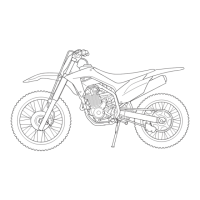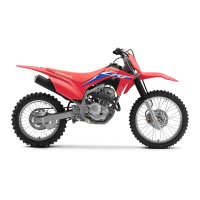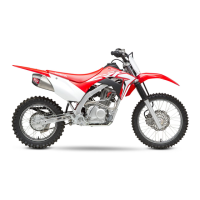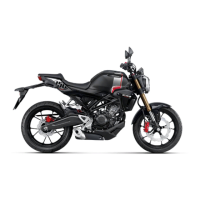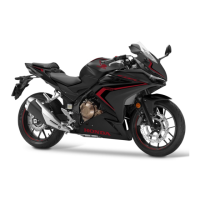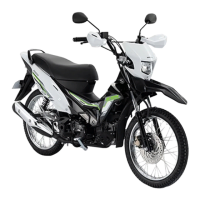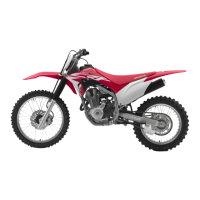
Do you have a question about the Honda CRF250F 2020 and is the answer not in the manual?
| Displacement | 249cc |
|---|---|
| Bore x Stroke | 71.0mm x 63.0mm |
| Compression Ratio | 9.6:1 |
| Ignition | CDI |
| Transmission | 5-speed |
| Final Drive | Chain |
| Front Tire | 80/100-21 |
| Rear Tire | 100/100-18 |
| Trail | 4.4 inches |
| Seat Height | 34.8 inches |
| Fuel Capacity | 1.6 gallons |
| Ground Clearance | 11.3 inches |
| Engine Type | Single-cylinder four-stroke |
| Rear Suspension | Pro-Link single shock |
| Front Brake | 240mm disc |
| Rear Brake | 220mm disc |
| Curb Weight | 265 pounds |
Important safety information, precautions on loading, accessories, mods, and label locations.
Location, function, and operation of basic controls like throttle, brakes, and clutch.
Importance of wearing helmet/gear and ensuring rider/motorcycle readiness.
Why maintenance is needed, schedule, and specific maintenance tasks.
Location of safety labels on the motorcycle, warning of hazards.
Safety messages preceded by alert symbols and signal words (DANGER, WARNING, CAUTION).
Safety Headings, Sections, and Instructions found in the manual.
Key information and recommendations for safe motorcycle riding.
Information on load limits, accessories, and modifications for safety.
Location and importance of safety labels on the motorcycle.
Emphasizes helmet use for reducing head injury severity.
States the motorcycle is designed for one rider only.
Motorcycle is designed and manufactured for off-road use only.
Developing off-road riding skills gradually and safely.
Recognizing and reacting to terrain challenges and potential dangers.
Avoiding crashes by not exceeding personal abilities or conditions.
Advises against mixing alcohol and riding due to impaired response.
Importance of proper maintenance for safe riding condition.
Information on how much weight to put on the motorcycle and how to load it safely.
Specifies the maximum weight capacity for the motorcycle.
Guidelines for carrying cargo, including keeping it small and light.
Recommends using Honda Genuine Accessories and checking compatibility.
Warnings about how modifications can make the motorcycle unsafe.
Advises against modifying original equipment that affects design or operation.
Identifies the location of various operating controls on the motorcycle.
Explains the function of the ignition switch and its positions.
Describes how to use the start button to begin engine operation.
Explains the emergency use of the engine stop button.
How to operate the front brake lever for slowing or stopping the motorcycle.
How to operate the throttle grip to control engine RPM.
How to use the clutch lever to disengage the clutch for shifting.
How to use the shift lever to select gears.
Evaluating personal riding readiness before each ride.
Recommendations for appropriate protective gear for riding.
How to perform a pre-ride inspection of the motorcycle.
Reading manual, understanding safety, knowing controls, and personal condition.
Always wear helmet, eye protection, boots, gloves, and protective clothing.
Items to check before riding: tires, spokes, rims, leaks, fluids, etc.
Essential precautions for safe motorcycle operation.
Procedures for starting and stopping the motorcycle's engine.
How to properly shift gears in the transmission.
Effective techniques for slowing and stopping the motorcycle.
Steps to take before starting the engine, including ignition switch and checks.
Steps for starting the fuel-injected engine under any temperature.
Procedure to follow if the engine fails to start due to excess fuel.
Sensor that stops engine if motorcycle is overturned.
How to stop the engine using the ignition switch.
Steps to start riding, including warming the engine and raising the side stand.
Applying front and rear brakes smoothly while downshifting.
Closing throttle and applying brake lever and pedal controls firmly.
Cautionary advice for braking in wet or loose surface conditions.
Lowering the side stand, turning off ignition, and choosing a level place.
Cleaning the motorcycle and inspecting for leaks or damage.
Information and recommendations prior to servicing.
Why regular maintenance is essential for safety and performance.
Important safety precautions to follow during maintenance.
Overview of the maintenance schedule for required servicing.
Preparations needed before starting service tasks.
Procedures for servicing fluids and filters.
Topics related to engine maintenance and service.
Topics related to chassis maintenance and service.
Maintenance is essential for safety, economy, and trouble-free riding.
Essential safety precautions for performing maintenance tasks.
Explanation of the maintenance schedule and service intervals.
Summary of notes and codes for maintenance procedures.
Using the record section to note maintenance performed and reminders.
Items to check before each competition event.
Location of clutch lever, throttle grip, and brake controls.
Location of air cleaner, oil filter, and brake pedal.
Location of spark plug, battery, and drive chain.
Information on tools needed for owner maintenance.
Step-by-step guide to remove the side covers.
Step-by-step guide to install the side covers.
Recommended unleaded gasoline type and octane number.
Step-by-step procedure for refueling the fuel tank.
Recommended oil specifications (API, viscosity, JASO).
Procedure for checking engine oil level and adding oil.
Step-by-step guide for draining and replacing engine oil.
Why proper air cleaner maintenance is crucial for engine health.
Detailed steps for cleaning the air cleaner element.
Specifies the recommended standard spark plug model.
How to service the spark arrester to maintain efficiency.
How to inspect the front suspension for proper operation and leaks.
How to inspect the rear suspension for proper operation and wear.
Step-by-step guide to adjust the front brake lever freeplay.
How to check the front brake fluid level against the LWR mark.
How to check the rear brake fluid level against the LOWER mark.
Checking for fluid leaks and hose/fitting condition.
How to inspect brake pads for wear using cutouts.
Criticality of true wheels and spoke tension for safe operation.
Inspecting wheel rims and spokes for damage and tightening loose parts.
Step-by-step procedure for removing the front wheel.
Step-by-step procedure for removing the rear wheel.
Properly inflated tires are crucial for handling, life, and comfort.
How to inspect tires for bumps, cuts, tread depth, and valve stem condition.
Procedure for replacing a punctured or damaged tire tube.
Guidelines for replacing tires, including tube replacement and balancing.
Checking side stand for damage, tension, and movement; lubrication.
How to check drive chain slack and inspect for constant tension.
Procedure for adjusting the drive chain slack.
Recommended lubricant and steps for lubricating the drive chain.
Procedures for removing, cleaning, and replacing the drive chain.
Information about the maintenance-free battery type.
How to properly store the motorcycle battery.
Step-by-step guide to remove the battery from the motorcycle.
How to charge the motorcycle battery using a recommended charger.
General advice for cleaning and polishing the motorcycle for longevity.
Step-by-step process for washing the motorcycle with mild detergent.
Specific care for painted exhaust pipes and mufflers.
How to clean and care for matte painted surfaces on the motorcycle.
Advice on preparing for an off-road motorcycle adventure.
Guidelines and recommendations for safely transporting the motorcycle.
Procedures to keep the motorcycle in good condition during extended storage.
Tips for being an environmentally responsible motorcycle owner.
Essential tools and supplies for potential issues encountered during rides.
What to take on the trail depends on terrain, duration, and rider experience.
How to secure the motorcycle upright using tie-down straps.
Thoroughly inspect and correct problems before storing the motorcycle.
Key steps to prepare the motorcycle for storage.
Procedures to follow when taking the motorcycle out of storage.
Stay on existing roads/trails, avoid damage, ride in approved areas.
Ride quietly, don't remove spark arrester, avoid muffler modifications.
Use biodegradable detergents, avoid CFCs, proper solvent disposal.
Proper disposal of used oil, gasoline, and solvents.
First steps when something goes wrong: stop safely, assess, identify.
What to do if the engine quits, won't start, or runs poorly.
How to handle a flat tire, including temporary repairs and seeking help.
How to check for and replace blown fuses.
How to address issues with starting or poor engine performance.
Troubleshooting steps when the starter motor does not operate.
Troubleshooting when engine won't start despite starter motor function.
Troubleshooting steps when the engine starts but runs poorly.
Further troubleshooting for engine performance issues like detonation or afterfires.
Handling flat tires on the trail, including temporary repair methods.
How to check for and replace blown fuses.
Steps to access and replace the main fuse.
Steps to access and replace the sub fuse.
Prioritize personal safety after a crash and assess motorcycle condition.
Importance of recording key numbers and obtaining duplicates.
Assessing damage and feasibility of trailside repairs for failing components.
Advice against jump-starting and recommendations for charging issues.
Information on identifying the vehicle via VIN and engine numbers.
Overview of technical specifications for the motorcycle.
Guidelines for breaking in the new motorcycle for reliability.
Information regarding exhaust and noise emission control systems.
Location of the Vehicle Identification Number (VIN) and its uses.
Key dimensions of the motorcycle.
Details on fuel tank capacity, reserve, and oil specifications.
Specific recommendations for engine oil and drive chain lubricant.
Passenger capacity, maximum weight, and cargo capacity.
Details on engine displacement, bore, stroke, and compression ratio.
Valve clearance, spark plug type/gap, and idle speed specifications.
Gear ratios and reductions for the power transmission.
Drive chain freeplay, new chain length, and service limit length.
Caster, trail, tire sizes, pressure, and suspension travel.
Battery type, voltage, capacity, and generator output.
Main and sub fuse amperage ratings.
Torque values for various bolts and nuts.
Paying extra attention during the first day or 15 miles for reliability.
Compliance with EPA, CARB, ECCC exhaust emission standards.
Compliance with EPA noise emission standards for motorcycles.
Explanation of carbon monoxide, NOx, and hydrocarbon emissions.
Description of the exhaust emission control system, including PGM-FI.
How the evaporative system maintains fuel vapor pressure.
How the crankcase system prevents emissions discharge.
Laws prohibiting tampering with noise control systems.
Symptoms indicating potential issues with motorcycle emissions.
Vehicle compliance with fuel permeation control regulations.
EPA-approved percentages of ethanol and methanol in gasoline.
Warnings about potential damage from oxygenated fuels.
Information on obtaining authorized Honda manuals.
Explanation of motorcycle limited, emission, and noise control warranties.
How to obtain warranty service for your Honda.
How to contact Honda for questions or comments.
Details on how to order service manuals and guides.
What the warranty covers (defects) and what it doesn't (wear, improper maintenance).
Process for getting warranty repairs from your dealer.
USA and Canada contact details, including email for comments.
How dealers provide maintenance, repairs, parts, and information.
Proper maintenance prevents premature wear and damage to engine and chassis.
Space to record VIN, owner, and dealer details for easy access.
Recommended intervals for maintenance and pre-ride checks.
Key data for fuel, oil, tires, and their capacities/pressures.
Spark plug type and fuse amperage ratings.
